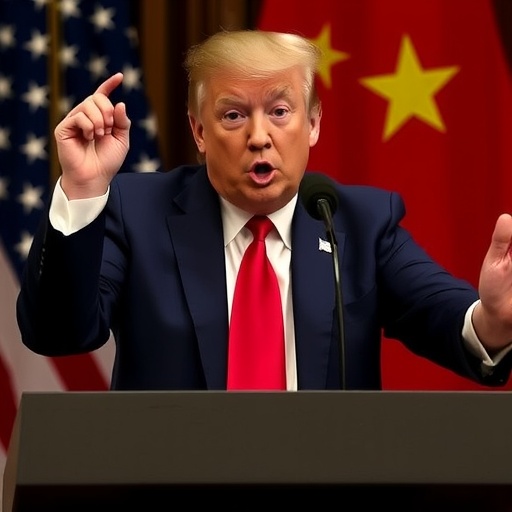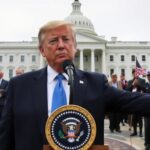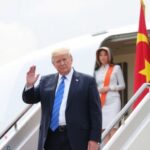Trump Issues Stark Warning: 155% Tariffs on China If No Trade Deal by November 1
In a bold escalation of the ongoing US-China trade tensions, President Donald Trump has warned that China could face crippling 155% tariffs on its exports if no trade deal is finalized by November 1. This ultimatum comes as Trump gears up for high-stakes talks with Chinese President Xi Jinping, while simultaneously inking new trade agreements with Asian allies to counter Beijing’s influence.
The announcement, delivered during a press briefing at the White House, underscores Trump’s aggressive strategy to pressure China into concessions on intellectual property theft, forced technology transfers, and market access barriers. ‘If we don’t have a deal by November 1, China will pay the price with tariffs like they’ve never seen,’ Trump declared, emphasizing that the US economy would not back down from what he called ‘unfair practices.’
This move arrives at a pivotal moment in the protracted trade war that has already cost billions in economic losses on both sides. Since 2018, the US has imposed tariffs on over $360 billion worth of Chinese goods, prompting retaliatory measures from Beijing. The proposed 155% tariff hike would represent a dramatic intensification, potentially affecting everything from consumer electronics to industrial machinery.
Trump’s Ultimatum Signals Endgame in US-China Trade Standoff
President Trump’s latest tariff threat marks a clear deadline in the drawn-out negotiations between the world’s two largest economies. Speaking to reporters, Trump reiterated his administration’s frustration with China’s slow pace in addressing core US demands. ‘We’ve been patient, but time is up. November 1 is the line in the sand,’ he stated, highlighting the need for enforceable commitments from Beijing.
According to trade experts, the 155% figure is not arbitrary; it builds on existing tariffs averaging around 25% on many Chinese imports, with the potential to stack penalties for non-compliance. The White House has indicated that this escalation could target key sectors like semiconductors and rare earth minerals, which are vital to US tech and defense industries.
Historical context reveals the depth of this rift. The trade war ignited in early 2018 when Trump slapped tariffs on steel and aluminum imports, citing national security concerns. China responded with duties on US agricultural products, hitting soybeans and pork hardest—exports that plummeted by over 70% in some cases. By 2019, partial deals had eased some tensions, but unresolved issues like subsidies to state-owned enterprises continue to fuel distrust.
Economists at the Peterson Institute for International Economics estimate that full implementation of 155% tariffs could shave 0.5% off US GDP growth in the following year, while inflating consumer prices by up to 10% on affected goods. For China, the blow could be even steeper, with export-dependent manufacturers facing bankruptcy risks. ‘This is high-stakes poker, and Trump is raising the bet,’ said trade analyst Emily Chen of the Brookings Institution.
High-Stakes Preparations for Trump-Xi Summit in Asia
As the November 1 deadline approaches, all eyes are on the anticipated summit between Trump and Xi Jinping, tentatively scheduled during Trump’s upcoming Asia tour. Sources close to the administration reveal that preliminary talks via video conference have already laid groundwork, focusing on agriculture, energy, and financial services—areas where China has shown willingness to open markets.
Xi Jinping, facing domestic pressures from a slowing economy exacerbated by COVID-19 recovery challenges, has signaled openness to dialogue. In a recent speech at the World Economic Forum, Xi emphasized ‘win-win cooperation,’ a phrase that US negotiators interpret as a nod toward compromise. However, Beijing’s state media has pushed back, accusing the US of ‘economic bullying’ and vowing to protect its sovereignty.
Trump’s itinerary includes stops in Japan, South Korea, and Vietnam, where he plans to strengthen alliances against Chinese expansionism. During these visits, discussions on supply chain diversification away from China will be central. For instance, Vietnam has already seen a 35% surge in US imports since the trade war began, positioning it as a key alternative manufacturing hub.
Security implications loom large as well. The tariff threat intertwines with geopolitical flashpoints like the South China Sea disputes and Taiwan tensions. Trump’s administration has linked trade progress to broader strategic dialogues, suggesting that a deal could ease military posturing in the region.
New US Trade Deals in Asia Counter China’s Influence
Amid the tariff saber-rattling with China, Trump is actively forging new trade pacts across Asia to isolate Beijing economically. On the sidelines of his Asia trip, the president is set to sign a landmark free trade agreement with India, aimed at boosting bilateral trade to $500 billion by 2030. This deal includes reduced tariffs on US pharmaceuticals and agricultural goods, while granting Indian tech firms greater access to American markets.
In Japan, Trump will announce an expansion of the US-Japan Trade Agreement, originally signed in 2019, to cover digital trade and e-commerce—sectors where China dominates globally. Japanese Prime Minister Yoshihide Ishiba has praised the partnership as a ‘bulwark against unfair competition,’ implicitly referencing China’s practices.
South Korea, a major US ally, is negotiating enhancements to the existing KORUS FTA, with focus on automobiles and semiconductors. These moves are part of Trump’s ‘America First’ vision to reshore critical industries. Data from the US Trade Representative shows that US exports to Asia excluding China rose 15% in 2023, a trend expected to accelerate with these new deals.
Critics, however, warn that fragmenting global trade could lead to inefficiencies. The World Trade Organization has expressed concerns over rising protectionism, noting that such bilateral pacts might undermine multilateral efforts. Nonetheless, supporters argue these agreements will pressure China to return to the negotiating table on fairer terms.
Economic Ripples: How 155% Tariffs Could Reshape Global Supply Chains
The specter of 155% tariffs on China extends far beyond bilateral relations, threatening to disrupt global supply chains that underpin everything from iPhones to electric vehicles. Analysts predict that companies like Apple and Tesla, heavily reliant on Chinese manufacturing, could see costs soar by 20-30%, prompting a rush to relocate production to countries like Mexico or Indonesia.
US farmers, already battered by previous trade skirmishes, stand to gain if a deal materializes—China has pledged to purchase $50 billion in American agricultural products annually under prior agreements. Without resolution, however, retaliatory tariffs could devastate Midwest exports once more. The American Farm Bureau Federation reports that farm bankruptcies spiked 20% during the 2018-2019 peak of the trade war.
On the Chinese side, the tariff hike could exacerbate unemployment in export hubs like Guangdong province, where factories employ millions. Beijing has invested heavily in domestic innovation to reduce US dependency, with R&D spending reaching 2.4% of GDP in 2023. Yet, experts like those at the Council on Foreign Relations doubt China’s ability to fully decouple without years of transition.
Financial markets have reacted swiftly to Trump’s warning. The Dow Jones Industrial Average dipped 1.2% in after-hours trading following the announcement, while the yuan weakened by 0.8% against the dollar. Commodities tied to trade, such as copper and soybeans, saw volatile swings, reflecting investor anxiety over prolonged uncertainty.
Broader implications include inflation pressures in the US, where the Federal Reserve has already hiked rates to combat post-pandemic price surges. A Moody’s Analytics report forecasts that escalated tariffs could add 0.3 percentage points to core inflation, complicating the Fed’s balancing act between growth and price stability.
Looking Ahead: Pathways to Resolution or Further Escalation
As November 1 draws near, the trajectory of US-China relations hinges on the Trump-Xi summit and subsequent negotiations. Optimists point to past breakthroughs, like the Phase One deal in 2020, which stabilized some sectors despite incomplete implementation. US Trade Representative Katherine Tai has indicated flexibility, suggesting that partial agreements on enforcement mechanisms could avert the tariff cliff.
Should talks falter, Trump has hinted at invoking Section 301 of the Trade Act for even broader measures, potentially including services and investments. China, in turn, might accelerate its Belt and Road Initiative to court alternative partners in Europe and Africa, further polarizing global trade blocs.
International observers, including the European Union, urge de-escalation to prevent a ‘new Cold War’ in economics. With midterm elections looming in the US, Trump’s hardline stance could rally his base but risk alienating business leaders who favor stability. Ultimately, the coming weeks will test whether diplomacy can bridge the divide or if the trade war enters a more destructive phase, reshaping the global order for decades.
In the interim, businesses worldwide are hedging bets—diversifying suppliers and stockpiling goods. As one Wall Street Journal op-ed noted, ‘The real winner in this standoff may be uncertainty itself, costing trillions in lost opportunities.’ The world watches closely as Trump and Xi navigate this high-wire act.










